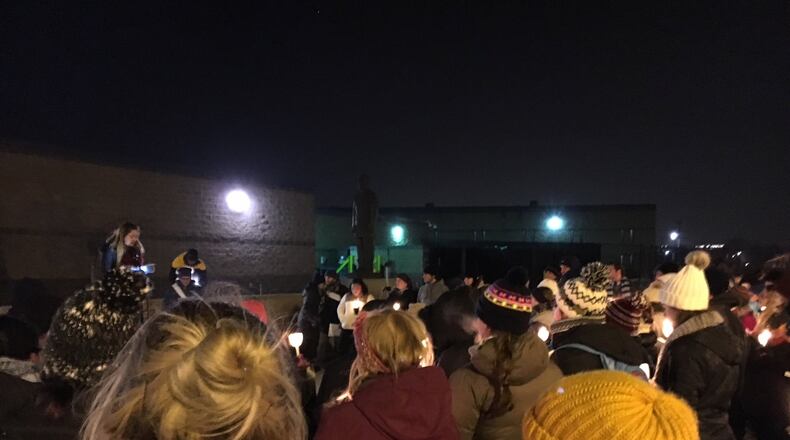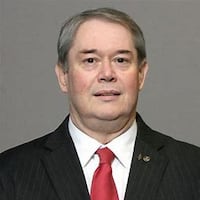The vigil, which lasted just over an hour, was held at the Butler County Jail which houses an ICE detention facility. It was organized by the University of Dayton's Human Rights Center and Campus Ministry Center for Social Concern and was also in partnership with the University of Dayton School of Law Human Rights Awareness and Advocacy Group and Our Lady of the Immaculate Conception Church in Dayton.
Just after 8 p.m., a school bus and a charter bus arrived at the Butler County Jail full of UD students and supporters for the vigil that also commemorated International Human Rights Day and the 70th anniversary of the adoption of the United Nations Universal Declaration of Human Rights.
Over the several few months, the Trump Administration has been accused of separating migrant families this summer — and some half-dozen families separated at the U.S.-Mexico border are still detained months after reuniting with their children — and American border agents use of tear case and force to prevent a migrant caravan from entering the country. President Donald Trump defended the use of tear gas, calling it a "very minor form," according to The Hill.
Organizers said the gathering aims to express solidarity for justice, peace and human dignity for all those who seek to migrate and find asylum in the U.S. They also expressed concern about various actions against asylum seekers that are violations of international human rights law and do not align with Catholic social justice teaching and values. Organizers said the vigil was located at the Butler County Jail because it was also the only ICE detention facility in the area.
The vigil consisted of several speakers, songs and prayers and as participants endured freezing temperatures Monday night.
Joel R. Pruce, an assistant professor of human rights studies at UD, spoke about the plight of immigrants and asylum seekers and that the indefinite detention of more than 10,000 children, family separations and attacks on asylum seekers were part of the intentional cruelty brought on by ICE.
“I think what’s important about this is that this is an issue that affects this area,” Pruce said. “People here care about this and so being able to create spaces like our vigil, for people to come out and spend some time and be together.”
Father Satish Joseph of Our Lady of Immaculate Conception Church in Dayton said he spent time in El Paso and Ciudad Juarez and came to know the plight of those asylum seekers.
“Seeking asylum is a human right … that there are many among us and we’re a country of immigrants,” he said. “America should continue to the say to the people what Lady Liberty says, ‘Give me all your weary and your poor’ … . We’re here to express our solidarity with them and to express our oneness.”
Rose Dyar, a University of Dayton senior studying human rights, said she attended to “stand in solidarity and show support and hopeful action” that things will change. Dyar has recently been to the border as part of the UD Moral Courage project and saw people crossing the border, what the wall looks like and what it does to families.
Crystal Sullivan, executive director of University of Dayton Campus Ministry, said it’s “especially important” to remember the plight of one family of refugees this time of year.
“According to the Gospel of Matthew, Mary, Joseph, and Jesus were refugees who fled Bethlehem into Egypt after Jesus’ birth in order to save Jesus from being killed with other innocent children,” she said.
Butler County Sheriff Richard K. Jones said on average, there are about 115 to 120 ICE detainees or about 10 percent of the jail’s daily population of about 1,000 inmates. He said the ICE detainees generate about $2.2 million a year for the county. He said the ICE detainees are held in separate pods from the other prisoners. Jones said they’ve had about the same number of detainees for the past 10 to 12 years.
The 287 (g) program delegates federal immigration law enforcement authority to local and state agencies. Jones said the Butler County Sheriff’s Office is one of 40 to 45 local law enforcement agencies in the nation with that authority.
Jones said when Barack Obama became president, he thought the number of immigration arrests would decrease. However, immigration arrests went up. “It was the damndest thing I’ve ever seen,” Jones said. “He deported more people than President Bush did.”
About the Author

